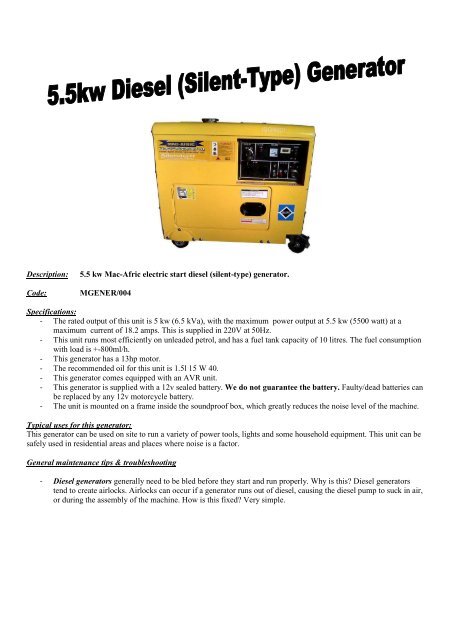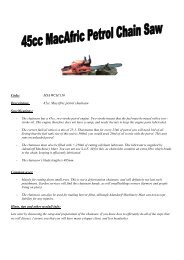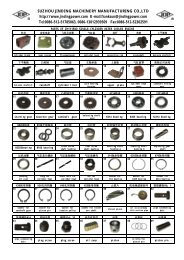The Air Lock Is Usually Created In The
The Air Lock Is Usually Created In The
The Air Lock Is Usually Created In The
Create successful ePaper yourself
Turn your PDF publications into a flip-book with our unique Google optimized e-Paper software.
Description: 5.5 kw Mac-Afric electric start diesel (silent-type) generator.<br />
Code: MGENER/004<br />
Specifications:<br />
- <strong>The</strong> rated output of this unit is 5 kw (6.5 kVa), with the maximum power output at 5.5 kw (5500 watt) at a<br />
maximum current of 18.2 amps. This is supplied in 220V at 50Hz.<br />
- This unit runs most efficiently on unleaded petrol, and has a fuel tank capacity of 10 litres. <strong>The</strong> fuel consumption<br />
with load is +-800ml/h.<br />
- This generator has a 13hp motor.<br />
- <strong>The</strong> recommended oil for this unit is 1.5l 15 W 40.<br />
- This generator comes equipped with an AVR unit.<br />
- This generator is supplied with a 12v sealed battery. We do not guarantee the battery. Faulty/dead batteries can<br />
be replaced by any 12v motorcycle battery.<br />
- <strong>The</strong> unit is mounted on a frame inside the soundproof box, which greatly reduces the noise level of the machine.<br />
Typical uses for this generator:<br />
This generator can be used on site to run a variety of power tools, lights and some household equipment. This unit can be<br />
safely used in residential areas and places where noise is a factor.<br />
General maintenance tips & troubleshooting<br />
- Diesel generators generally need to be bled before they start and run properly. Why is this? Diesel generators<br />
tend to create airlocks. <strong>Air</strong>locks can occur if a generator runs out of diesel, causing the diesel pump to suck in air,<br />
or during the assembly of the machine. How is this fixed? Very simple.
<strong>The</strong> air lock is usually created in the diesel pump. <strong>The</strong><br />
safest way to clear this is by firstly removing the silver pipe<br />
from the diesel pump, as well as the black rubber hose<br />
from the solenoid valve.<br />
<strong>The</strong> black rubber hose bring diesel from the tank to the<br />
diesel pump and the silver pipe transports the diesel to the<br />
engine.<br />
An air lock occurs when an air bubble prevents the plunger<br />
inside the pump to act as a diaphragm. <strong>The</strong> bubble resists<br />
the movement of the plunger which prevents diesel from<br />
being pumped through to the engine.<br />
Connect the ends of the two pipes together. By doing this, you<br />
have bypassed the diesel pump. Diesel will now flow directly<br />
into the silver pipe towards the injector.<br />
Reconnect the pipes as per the first picture. <strong>The</strong> air bubble will<br />
now be sucked through the system upon starting the generator.<br />
To start the generator, pull down on this decompression<br />
lever and turn the ignition. Make sure that the fuel tap is<br />
open. This is found just below the tank.<br />
When the generator starts you should let it run for +- 30<br />
seconds before killing the engine.<br />
Refer to the next section if you experience any further<br />
problems.<br />
- <strong>The</strong> generator does not start after checking for an air lock. <strong>The</strong>re could be two possibilities to this happening.<br />
<strong>The</strong>re is a problem on either the solenoid valve or the diesel pump. Firstly, make sure that the fuel tap is open and<br />
that diesel reaches the solenoid valve.<br />
Disconnect the silver pipe from the diesel pump and start the machine. A working solenoid valve should allow a<br />
few drops of diesel to be squirted out from the diesel pump’s outlet. You should also hear a loud “click” sound as<br />
the magnet disengages the valve.
If none of these happen, first replace the solenoid valve before checking the diesel pump itself.<br />
- <strong>The</strong>re is a “click”, but no boom, or squirting. It has happened in the past where the plunger mechanism in the<br />
diesel pump has rusted solid. To fix this, remove the diesel pump and spray Q20 or any anti-rust & lubricating<br />
agent onto the spring and plunger.<br />
Leave the pump for about half an hour to allow the Q20 to properly loosen the rust and lubricate all the parts.<br />
Take a rubber mallet and hit the bottom of the plunger until it moves freely again.<br />
Replace all the parts, connect the pipes and you should have a working generator.<br />
- Remember the oil sensor. <strong>The</strong> generator comes standard with an “oil level sensor”, of which the main function is<br />
to protect the engine when the oil level is too low. This is easily resolved by checking the dipstick, situated at the<br />
bottom of the sump, and adding oil. If the generator still does not start, unplug the yellow wire protruding from<br />
the side off the generator from the green wire. This is the oil sensor’s wire. Start the generator, and let it run for 5<br />
minutes before reconnecting the two wires. <strong>The</strong> engine should cut out if the oil sensor is faulty. This is easily<br />
replaced with a new oil sensor, available from our spares department. It is very important that your generator<br />
is placed on a level area whilst in use, otherwise the oil sensor may not pick up that there is no oil in the<br />
sump. This may cause your engine to overheat and seize.<br />
- <strong>The</strong> engine is running, but there is no power output from the plugs. This generator comes standard with an<br />
AVR unit. What does this do? <strong>The</strong> AVR is best explained as follows. It can be seen as a tap with a fuse. Why a<br />
tap with a fuse? Just like a tap, the AVR “opens” to allow a certain amount of current through, for instance, if you<br />
need 2kw from a 4kw generator, the AVR will allow 2kw of power through. It does this by raising the engine’s<br />
revolutions enough so that the alternator supplies the needed power. When you turn the tool off, the AVR drops<br />
the engine’s revolutions to an idle.<br />
<strong>The</strong> AVR acts as a fuse when the demand for power is too high. Every generator can supply a maximum amount<br />
of power. <strong>The</strong> 4kw can give 4.5kw maximum. When you try and run a geyser, which may need 5kw, the AVR<br />
will burn out, cutting the supply from the alternator to the plugs. Excessive demands for power such as this may<br />
lead to the field coil windings burning. <strong>In</strong> these cases a rewind is needed, which is very costly. <strong>The</strong> AVR, which is<br />
available as a spare part, is replaced by removing the black cover from the alternator, and removing the banana<br />
shaped block. This is the AVR, and must be replaced when damaged.<br />
- Will a welding machine run from my generator? Looking at old technology welders, such as the oil bath type,<br />
the answer is definitely no. Traditional oil bath welders require large amounts of current, sometimes up to 40<br />
amps, to function properly. This is much more than any of our petrol generators can supply. <strong>The</strong>y also tend to<br />
cause power fluctuations as they only pull power when you weld. <strong>The</strong> generator will basically go from idling to<br />
full power, back to idling, back to full power, which will cause major damage to the motor and windings.<br />
- What about my inverter welder? We do not advise the using an inverter on any of the generators. <strong>The</strong> fluctuation<br />
in current causes damage to vital parts on the pc-boards. You will however, in case of an emergency, be able to<br />
run a 160 amp inverter on NO MORE THAN 90amps off the 5.5kw generator.<br />
- Using an extension on the generator. It is possible that you may need to use an extension from the generator.<br />
Please keep the following in mind. A Proper 2.5mm core extension must be used. <strong>The</strong>n, for every 10metres of<br />
length, there will be an approximate power loss of 500w – 600w (2.2amps – 2.7amps). Keep this in mind,<br />
especially when using lengths of up to 40m that will equal a loss of about 2000w.







